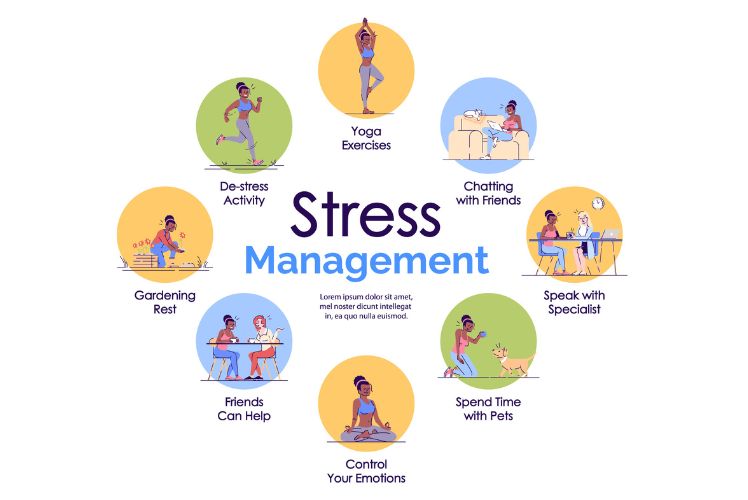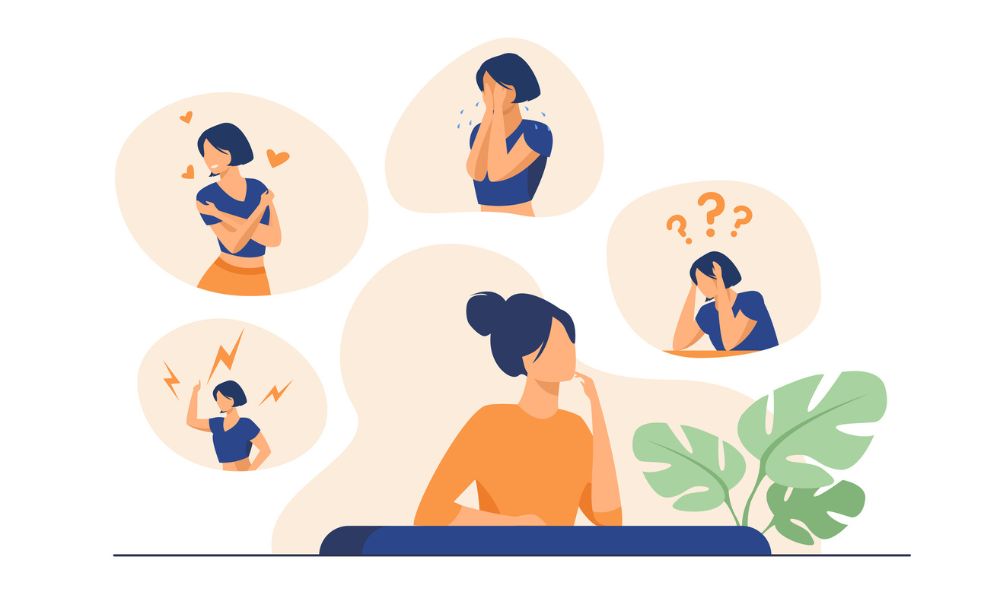In our fast-paced lives, moments of stress and anxiety can pop up unexpectedly. Knowing simple techniques to calm ourselves down can make a big difference in these heated moments. By taking control of our reactions, we can navigate through challenges with a clearer mind and a steadier heart.

Whether it's a heated discussion or daily pressures, we all face situations that can overwhelm us. In this article, we will explore practical strategies that we can use right away to find calm. These techniques include breathing exercises, physical actions, and mindfulness practices that can help us regain our focus and reduce tension.
By mastering these techniques, we can enhance our ability to handle stress and stay grounded in tough situations. Getting to know and understand what triggers our anxiety allows us to better manage our emotional responses. Let’s dive into these effective methods that can help us remain calm even when the pressure is on.
Key Takeaways
- We can use breathing techniques for immediate stress relief.
- Grounding practices help us stay present and reduce tension.
- Understanding our triggers allows us to manage our reactions better.
Understanding Stress and Its Triggers

Stress affects everyone in different ways. By recognising our own stress signals and identifying common stressors, we can better manage how we respond to stressful situations.
Recognising Personal Stress Signals
We all have unique ways our bodies show stress. Some common physical signals include increased heart rate, muscle tension, or headaches. Emotionally, we might feel overwhelmed, irritable, or anxious.
Being aware of these signals is key. For example, if we notice that our shoulders are tense or we’re clenching our jaws, it might signal that we need to take a step back. Keeping a stress diary can help track these signals over time.
Jot down when we feel stressed and what signs appear. This reflection can reveal patterns and offer better awareness of our own reactions to stress.
Identifying Common Stressors
Identifying stressors is essential for managing stress. Stressors can come from various sources in our lives. Some examples include work pressures, personal relationships, or financial issues.
We can also list daily stress triggers. For instance, deadlines, crowded places, or lack of sleep can add to our stress.
Recognising these triggers helps us prepare for them. If we anticipate that a busy commute causes stress, we can try to leave earlier or find quieter routes. Taking control and knowing our stressors is important for our well-being.
By staying aware of what stresses us, we can develop effective coping strategies. This understanding empowers us to handle stress more effectively.
Breathing Techniques for Immediate Relief

When we find ourselves in stressful situations, our breath can be a powerful tool for calming our minds and bodies. Using the right breathing techniques can help us regain control and ease anxiety quickly.
Deep Breathing Method
The deep breathing method focuses on taking slow, deep breaths to calm our nervous system. To practice this, we should begin by finding a comfortable sitting or lying position.
- Place one hand on our belly and the other on our chest.
- Inhale deeply through our nose, ensuring our diaphragm (not our chest) rises.
- Hold the breath for a few seconds.
- Exhale slowly through our mouth, allowing our belly to fall.
Repeating this process for five to ten breaths can significantly lower stress levels. We may notice that our heart rate decreases and our mind begins to clear.
Rhythmic Breathing Strategy
The rhythmic breathing strategy involves establishing a steady pattern to our breaths. This technique is helpful for calming racing thoughts.
- We can start by inhaling for a count of four.
- Hold the breath for a count of four.
- Exhale for a count of four.
- Wait for another count of four before inhaling again.
This method encourages a sense of balance and can be done anywhere. We can adjust the counting to suit our comfort level, making it a flexible option for immediate relief. Regular practice can improve our ability to respond to stress calmly.
Physical Strategies to Reduce Tension

When we feel tense, using physical strategies can help us quickly ease our discomfort. Two effective techniques are Progressive Muscle Relaxation and Gentle Stretching Exercises. These methods focus on physical awareness and movement to promote calmness.
Progressive Muscle Relaxation
Progressive Muscle Relaxation involves tensing and then relaxing specific muscle groups. We can start with our feet, clenching the muscles tightly for a few seconds before releasing. This technique encourages us to notice the difference between tension and relaxation.
We should proceed through each muscle group, including the calves, thighs, abdomen, arms, and face. Take deep breaths as we tense and relax, which helps to further reduce stress. Practicing this method for about 10–15 minutes can lead to significant calmness and heightened awareness of bodily sensations.
Gentle Stretching Exercises
Gentle stretching can also help reduce tension in our bodies. Simple stretches can relieve tight muscles and improve circulation. We can incorporate stretches for our neck, shoulders, and back, which are common areas of tension.
For example, we might gently tilt our head to one side while taking deep breaths, holding for 15–30 seconds. Similarly, we can reach our arms overhead and lean to one side to elongate our torso. Incorporating such stretches into our daily routine, even for a few minutes, can help release tension and improve our overall sense of well-being.
Quick Mindfulness and Meditation Practices

Mindfulness and meditation techniques can help us regain control in stressful situations. Here, we’ll explore two effective methods to centre ourselves and find calm.
Focusing on the Present
Focusing on the present moment is a core mindfulness practice that helps reduce anxiety. We can start by simply taking a few deep breaths. Inhale deeply through the nose and exhale slowly through the mouth. This helps centre our attention.
Next, we can gently tune in to our senses. Notice what we can see, hear, feel, and smell in our immediate environment. For example, we might observe the texture of a nearby object or listen to the sounds around us, like birds chirping or the rustle of leaves.
When distractions arise, we acknowledge them without judgement and guide our focus back to our breath and surroundings. This process helps ground us and shifts our mindset from reactive to responsive.
Guided Visualisation Techniques
Guided visualisation is a powerful technique where we create a mental image of a calming scene. It can be as simple as imagining a peaceful beach or a serene forest.
To start, we sit comfortably and close our eyes. We take a few deep breaths to relax. Then, we visualise ourselves in that safe space. We imagine the sounds, scents, and feelings associated with that place.
We can also use guided audio resources for support. Many practices are available online, including those that help us focus on reducing anxiety. Engaging in this mental imagery helps reduce stress and improves our emotional state, allowing us to react more calmly.
Emotional Grounding Through Sensory Awareness
Emotional grounding helps us stay present and calm, especially during stressful moments. By using our senses, we can connect with the immediate world around us. This technique boosts our focus and reduces overwhelming feelings.
The Five Senses Approach
Engaging our five senses can be an effective way to manage anxiety and stress. Each sense provides unique tools to help us ground ourselves.
Sight: We can focus on things around us, like colours, shapes, or patterns. For example, looking at a tree’s leaves moving in the wind can distract us from anxious thoughts.
Sound: Listening to calming sounds, like birds singing or water flowing, can help centre our minds. Paying attention to these gentle noises redirects our focus.
Touch: Physical sensations can anchor us to the moment. Rubbing our hands together or feeling the texture of an object can bring us back to the present.
Taste: We can take small sips of water or savour a piece of chocolate. This not only engages our taste buds but also encourages mindfulness.
Smell: Inhaling soothing scents, such as lavender or citrus, can evoke calming feelings. Using a scented candle or essential oils can enhance our experience.
Cognitive Approaches to Manage Overwhelming Thoughts
When we find ourselves overwhelmed by thoughts, using cognitive approaches can be highly effective. These methods allow us to process our feelings and change our mindset to feel calmer.
Challenging Negative Self-Talk
Negative self-talk can intensify our stress. To combat this, we should first recognise when such thoughts arise. It's important to ask ourselves if these thoughts are based on facts or assumptions.
We can create a list of our negative thoughts and then counter them with positive affirmations. For instance, if we think, "I am not good enough," we replace it with, "I am capable and have achieved many things." This shift can help us view situations more realistically and reduce our anxiety.
Practising this consistently trains our mind to focus on constructive thoughts, which can lessen overwhelming feelings.
Reframing Perspective
Reframing is another powerful technique. This involves looking at a situation from a different angle. Instead of viewing a challenge as daunting, we can see it as an opportunity for growth.
For example, if we face criticism, we can choose to see it as feedback for improvement, rather than a personal attack. Listing the potential benefits of a situation, even a stressful one, can help us shift our focus.
Additionally, we can practise gratitude by noting things we appreciate about ourselves and our lives. This simple exercise can lead to a more balanced perspective, which helps us stay calm and collected in the heat of the moment.
Long-term Strategies for Maintaining Calm
To help us stay calm in challenging situations, we can adopt effective long-term strategies. Developing a regular relaxation routine and making specific lifestyle changes are essential steps we can take to manage stress effectively.
Developing a Regular Relaxation Routine
Creating a relaxation routine can help us lower stress and stay calm over time. We might start by setting aside time each day to focus on relaxation techniques.
Practices like deep breathing, meditation, or yoga are great options. Deep breathing involves inhaling slowly through the nose and exhaling through the mouth.
We can also explore guided imagery, where we visualise a peaceful setting. Setting a consistent time for these practices can make it easier to stick to the routine.
Incorporating these techniques regularly can lead to better emotional control in stressful situations.
Lifestyle Changes for Stress Management
Our daily habits play a significant role in how we manage stress. Making specific lifestyle changes can transform our ability to remain calm.
First, maintaining a balanced diet contributes positively to our mood and energy levels. We should aim for plenty of fruits, vegetables, and whole grains.
Regular exercise is another crucial element. Activities like walking, cycling, or swimming help release endorphins, which improve our mood.
Getting adequate sleep is also vital. We should aim for 7-9 hours of quality sleep each night.
Additionally, connecting with friends and family can provide emotional support. Taking the time to engage in hobbies we enjoy further contributes to our overall well-being.
By focusing on these lifestyle changes, we can build resilience to stress and promote a calm mindset.
Frequently Asked Questions
In this section, we will address common questions about calming techniques that can help us manage our emotions effectively. These methods can support us in various situations where we might feel overwhelmed or anxious.
What are effective methods for calming down when feeling overwhelmed?
We can use techniques like deep breathing to calm ourselves. Taking deep breaths in through the nose and out through the mouth helps lower our heart rate. Mindfulness practices, such as focusing on the present moment, can also ground us and reduce overwhelming feelings.
What strategies can one employ to quickly soothe nerves?
To soothe our nerves, we may try physical activities such as taking a short walk or stretching. Engaging in a favourite hobby can also serve as a distraction. Listening to calming music or nature sounds can significantly reduce anxiety levels.
What are the steps to manage anger in stressful situations?
When feeling angry, we should pause and take a few deep breaths. This helps to clear our minds. Next, we can express our feelings calmly without using aggressive language. Identifying the problem and seeking a constructive solution can guide us toward better outcomes.
Which techniques can help in stopping overthinking and calming the mind?
We can practise grounding techniques, like focusing on our surroundings or describing objects around us. Writing down our thoughts can also help clarify what is troubling us. Additionally, we may use visualisation to picture a calm, safe space in our minds.
How can one address anxiety swiftly during a panic attack?
During a panic attack, we should try to control our breathing by inhaling slowly and exhaling over a longer period. Counting our breaths can help anchor us. It may also be useful to focus on a specific object and describe it in detail to distract our mind from the panic.
Is there a quick exercise to regain composure under acute stress?
A quick exercise involves taking three deep breaths while holding our hands over our stomachs. This helps us feel our breath and brings awareness to our bodies. We can also try squeezing a stress ball or doing a quick series of stretches to release tension.





















